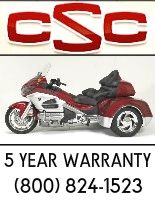GoldWingrGreg
JustWings.com
I was on a ride yesterday with 8 GL1800s, when over the CB, one rider was advising us all to watch our temp gauges. The climate was sunny and between 95-97 degrees, and for about 10 miles we traveled, as a group, between 15-20mph. They were all 2006s and up. Of the 8 Wings, 3 reported seeing their temperature gauges climb, while the other 5 didn't. I'm comparing here the 3 with high needle movement to mine.
- 2013 high temp on gauge - 2up combined weight 400lbs
- 2010 high temp on gauge - 2up combined weight 400lbs
- 2008 high temp on gauge - trike solo weight 220lbs
- my bike 2007 no needle movement combined weight 395lbs pulling a trailer. My bike had by far the highest mileage on the ODM with 157,000 miles, and it has no restrictions for radiator airflow, and the coolant has been changed at least every 24k.
A healthy cooling system is not rocket science. It mainly boiled down to 2 reasons my temp. gauge needle didn't move and theirs did.
- a "by the book," well maintained, cooling system
- no accessories blocking airflow in or out of the radiator grills
- one could argue this ... but under the circumstances above, should it be considered ???
Owner's Manual "
Normally, the needle on your temperature gauge will rise to a point aboutmidway between C (cold) and H (hot) and then level off. Hot weather maycause the needle to rise higher than normal. So will temporary stress such asclimbing a hill. If you’re stuck in stop-and-go traffic, the needle may climbsome, but the radiator fan is designed to prevent overheating. Be aware of thesevariations as you monitor the gauge.
If your vehicle is operated at sustained speeds between 10 and 15 miles perhour in high ambient temperature conditions, you may experience hightemperature gauge readings.
If the temperature gauge rises, shifting to second gear or altering your speed(either faster or slower) may reduce the temperature reading. If the indicatorreaches the red zone, as soon as it is safe to do so, pull over and let the engineidle until the indicator drops."
- 2013 high temp on gauge - 2up combined weight 400lbs
- 2010 high temp on gauge - 2up combined weight 400lbs
- 2008 high temp on gauge - trike solo weight 220lbs
- my bike 2007 no needle movement combined weight 395lbs pulling a trailer. My bike had by far the highest mileage on the ODM with 157,000 miles, and it has no restrictions for radiator airflow, and the coolant has been changed at least every 24k.
A healthy cooling system is not rocket science. It mainly boiled down to 2 reasons my temp. gauge needle didn't move and theirs did.
- a "by the book," well maintained, cooling system
- no accessories blocking airflow in or out of the radiator grills
- one could argue this ... but under the circumstances above, should it be considered ???
Owner's Manual "
Normally, the needle on your temperature gauge will rise to a point aboutmidway between C (cold) and H (hot) and then level off. Hot weather maycause the needle to rise higher than normal. So will temporary stress such asclimbing a hill. If you’re stuck in stop-and-go traffic, the needle may climbsome, but the radiator fan is designed to prevent overheating. Be aware of thesevariations as you monitor the gauge.
If your vehicle is operated at sustained speeds between 10 and 15 miles perhour in high ambient temperature conditions, you may experience hightemperature gauge readings.
If the temperature gauge rises, shifting to second gear or altering your speed(either faster or slower) may reduce the temperature reading. If the indicatorreaches the red zone, as soon as it is safe to do so, pull over and let the engineidle until the indicator drops."






